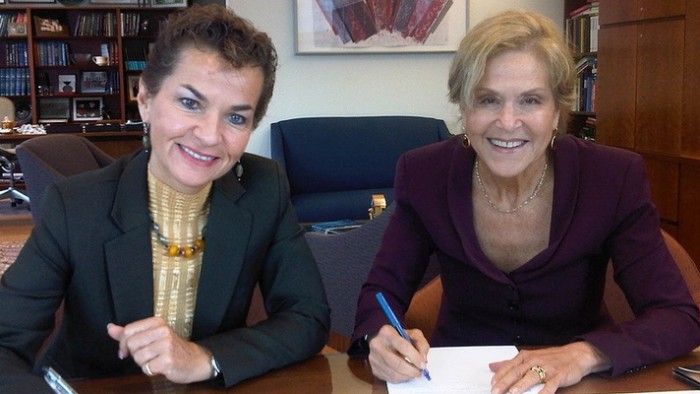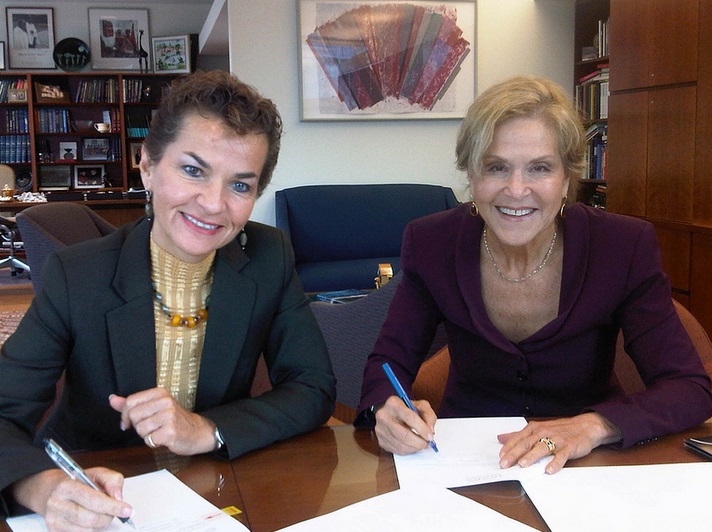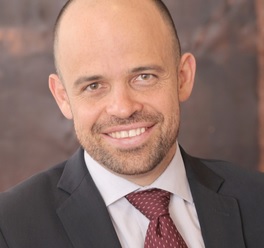The Rockefeller Foundation’s Climate-Finance Strategy

In this interview, Lorenzo Bernasconi, senior associate director of innovative finance and impact investing at The Rockefeller Foundation, shared his perspective on the organization’s grant-making strategy around climate solutions.
The interview has been edited by the Yale Center for Business and the Environment news team.

Framework Convention on Climate Change (UNFCCC),
and Judith Rodin, president of the Rockefeller Foundation,
collaborated during and after the Paris Agreement.
(Credit: United Nations)
CFN: 2015 marked the adoption of the Sustainable Development Goals (SDGs) and the historic Paris Climate Conference, COP21. Stakeholders have made generous pledges of investments in clean energy and climate resilience, picturing a bright future for the planet. What is the vision your foundation is developing to make the dream a reality?
Bernasconi: The Rockefeller Foundation has two primary areas of focus: fostering resilience and building inclusive economies. As such, the foundation has several large, multi-year initiatives that contribute directly towards the achievement of the SDGs and the Paris Agreement.
This includes, for example, Smart Power for Rural Development, a $75 million initiative working to deliver clean and affordable electricity and catalyze economic development among underserved rural communities across India.
Within the Innovative Finance team, we address the critical challenge of how to finance the SDGs and investments necessary to achieve the promise of the Paris Agreement.
There is a widespread consensus that we need to massively increase investments in health, education, access to clean water, and other critical sectors. This is to achieve the SDGs and significantly increase investments in a low-carbon economy. This includes energy, infrastructure, agriculture and transportation.
At the same time, we know that governments and philanthropists have nowhere near enough resources to meet these funding gaps alone. And so the question arises: how can we incentivize more private-sector capital to flow toward addressing the SDGs and the Paris Agreement?
The focus of the Zero Gap Portfolio of the Innovative Finance team is to develop practical solutions that address this question. We [develop] very early-stage ideas around financing solutions that have the potential to mobilize large-scale private-sector capital to address the world’s most difficult challenges, including climate change.
Given the scale of the challenge and political momentum generated by the Paris Agreement, quite a lot of our portfolio is climate-focused. The climate space is one where we believe that the development of new financing solutions is particularly important.
While there will be a continuous need to develop the next generation of clean-energy technologies, addressing the massive need for investment into renewable energy and climate-smart infrastructure to avoid the most catastrophic effects of climate change is not a technological problem.
We fortunately already have a broad set of proven [technology] solutions that we know to be effective and cost-efficient. The challenge is about finding the right financing solutions or business models to incentivize large-scale investment into them so that they are widely adopted and scaled up.
This is the challenge that our team seeks to address through identifying early-stage innovative financing solutions with a potential for scale.
As a philanthropic institution, we are in a privileged position to do this because we can take on development risks and make significant investments to help launch pilot transactions that traditional market players cannot.

implement climate financing at The
Rockefeller Foundation.
CFN: How does the foundation plan to assist with the biggest challenges involved in keeping the COP21 commitments and deploying capital?
Bernasconi: The Paris Agreement is an incredible achievement, but the truth is that many of the commitments at the country level, or Intended Nationally Determined Contributions (INDCs), have not yet been fully owned by countries. In many cases, governments are still struggling to work out how they are actually going to deliver on them.
What we do know is that there is no way governments alone can make the investments that are necessary.
With this in view, a very important lever that government has is that of policy and regulation. Needless to say, this a key component to the solution but it is not where our primary focus lies. Our goal is more on developing investment-focused solutions rather than policy-driven campaigns.
In line with our early work on spurring the impact-investing industry, we are looking to create new investment solutions that meet the risk and return requirements of large-scale investors while delivering positive environmental or social impact.
More specifically, we hope that over the next 5-10 years, we will be able to demonstrate a number of new financial solutions that are successful and mobilize large scale private capital - and have these [mechanisms] replicated globally. That is where our threshold for success lies.
CFN: What are the climate-finance impact areas the foundation focuses on?
Bernasconi: If I were to give a label to the focus area of our work, it would be that of rethinking traditional investment vehicles – that is, rethinking how investments are made. By creating new investment vehicles that better match the opportunities and challenges posed by climate change as well as by the needs of investors, we hope we will unlock new, critically needed investment.
There is an interesting market failure around this question, which opens up an important role for philanthropy.
Perhaps surprisingly, the traditional engines of financial innovation – investment banks and asset managers – have not centrally focused on the question of how to shift the trillions of dollars in investment toward a low-carbon economy, let alone how to finance the SDGs. The incentives are not there yet.
Multilateral banks and international finance institutions [such as the World Bank] have made some big commitments around climate finance. They are driving innovation, but they are limited in their ability to take on early-stage development risks.
This opens up an important role for philanthropy in supporting high-potential ideas that would otherwise struggle to get off the ground. Against this background, there are a number of ideas we are supporting in the climate space that are worth highlighting.
Long-term institutional investors such as pension funds would appear to be, at least in theory, perfect candidates for investment into low-carbon infrastructure such as renewable energy.
Given the appropriate regulatory environment, renewables offer stable, long-term cash flows that meet the long-term liabilities and investment horizons of institutional investors. And yet, we lack the right investment vehicles to take advantage of this opportunity at scale.
Where institutional investors don’t have the size or expertise to invest directly in renewable-energy projects, the traditional approach is to invest in pooled investment funds with debt, equity, or a combination of the two.
The challenge with these funds is that they carry high fees and generally have an investment [time frame] that is shorter than that of institutional investors or the assets in which they invest.
Factoring in the economics and structure of these funds against the backdrop of a low-interest-rate environment, it is difficult for institutional investors to meet their required investment returns through such vehicles. As a result, investment flows into renewable energy have suffered.
However, if we rethink the investment vehicle, there is (potentially) a way of unlocking new capital flows. This is what we are exploring with the Climate Policy Initiative, with which we are looking to develop… an investment trust that addresses the fundamental needs of long-term institutional investors.
Another example of our efforts to create a new innovative finance solution in the climate space is the Forest Resilience Impact Bond.
Currently, very little investment capital flows towards the restoration and maintenance of forests despite the proven value of these interventions to reduce the risk and intensity of forest fires.
We are working together with Blue Forest Conservation, among others, to develop a new type of bond in California to enable these investments at scale, thereby reducing the risks of forest fires.
Around questions of climate, we have also been actively working in the insurance space. Insurance offers a unique and much-needed set of solutions to build resilience against the impacts of climate change.
Working with African Risk Capacity, we are helping finance the R&D for the Extreme Climate Facility, an insurance product designed to access private capital for climate adaptation efforts across Africa should the frequency of extreme-weather-events increase in the region.
Finally, an area that we have also been exploring on the climate front is infrastructure – specifically, infrastructure that builds resilience. Current infrastructure is largely ill-prepared for the impacts of climate change, [globally].
At the same time, infrastructure built right – including green infrastructure – is critical to helping cities and communities address the consequences of climate change. With this view, we supported a Swiss NGO, Global Infrastructure Basel (GIB).
The foundation actively seeks to engage other market players in moving forward the space of climate finance.
Collaborating with credit-rating agencies, for example, we urge them to take into consideration the resilience dimensions of a city. We believe that a more resilient city is also better equipped to protect its assets. It also is better suited to lower its insurance premiums and meet lower financing costs. This altogether reflects in its higher credit rating. This incentive in its own would drive more cities to make the right type of infrastructure investments.
We have been piloting this idea with GIB to develop a new credit-rating approach that incorporates the long-term resilience dimension of an infrastructure asset.
The idea behind this project is to quantify, price, and value the positive effects of a more resilient structure – thereby lowering the cost of capital and insurance premiums for developers.
GIB worked closely with industry experts and the foundation to incorporate our expertise in resilience resulting in the creation of the SuRe standard.
Dagong Global Credit Rating, a leading Chinese credit rating agency, is the first to incorporate the SuRe standard. We are very excited about this, given how much global infrastructure will be financed and built by China.
Incorporating a resilience lens into these investments will be critical if we want to address the effects of climate change.
CFN: Can you describe your team’s approach to choosing the projects in which to invest climate finance?
Bernasconi: We look at new opportunities through the lens of four sets of criteria.
First, we look at impact: the solutions need to be in direct and measurable support of addressing the world’s most pressing challenges.
Second, we look at scale: all of the solutions we fund need to have a market potential of at least $1 billion at maturity.
Third, we look at replicability: all solutions need to have the potential to apply and scale across different issue areas or geographies.
Fourth, we look at innovation: solutions need to break from current practice in order to mobilize more money or improve the efficiency of current flows.
If a proposed idea looks promising through the lens of these dimensions, we then explore the idea against a further set of criteria to help us prioritize the decision process.
These criteria include the need for philanthropic support, the size and complexity of the addressed challenge, our role as a partner, the quality of the team, and the overall risk profile of the project.
Although we tend to have high risk tolerance, we ideally want to match the risk of a project with the entrepreneurs’ team. We want to ensure that they have a very clear action plan and the resources to conceivably be successful at that project.
We seek to support truly transformative ideas whether they come from early stage entrepreneurs who develop a new type of financial instrument or experienced professionals solving gaps in established institutions.
CFN: What is the return that the foundation seeks from its climate investments? What is the right balance between financial performance and environmental impact?
Bernasconi: We approach our climate investments holistically. If we want to be successful in mobilizing large-scale capital that benefits poor and vulnerable people and addresses the world’s most pressing challenges, we need to meet the risk-return requirements of mainstream investors while ensuring, on the other hand, the robustness of the impact – regardless of whether ‘impact’ is part of the investment strategy of these investors.
There are two major reasons underlying this thinking. First, we simply do not have enough time to wait until impact investing catches on to mobilize the trillions of dollars necessary to move toward decarbonization. We need to mobilize this money as quickly as possible.
Second, the foundation wants to see its ideas are picked up by the market. In that respect, we need to be able to address the needs of the market participants while ensuring that these investments are addressing critical challenges, particularly those affecting poor and vulnerable communities.
CFN: Do you plan to provide public access to the information on the climate funds allocation for greater visibility of the impact? Why or why not?
Bernasconi: On the grant-allocation side, we have every interest in making our work as public as possible. We wish to not only demonstrate what has been successful and why, but give detailed information, provide blueprints as to how these ideas can be replicated to benefit the greater public good.
A critical part of the commitment of working with us involves a public-good dimension that goes beyond the particular benefit that a particular company, NGO or fund might get.
The Zero Gap Portfolio has supported 17 projects. To date, only one has gone into the pilot stage. As the project pipeline grows and develops, we will continue sharing their impact and development.
The Foundation is committed to transparency and regularly reports on its program-related investments as well. It is fair to note, though, that it has been only a couple of years since most climate-finance investments have been launched and thus it will take time to share the results more broadly and make the information public.
CFN: How long do you think the clean-energy transition will take?
Bernasconi: Christiana Figueres said recently that the future of humanity depends on the decisions that institutional investors make within the next five years. The science suggests she is right. While it is unlikely that we will heed her warning quite so quickly, I remain hopeful that we will get there in 10.
My assessment is based on a number of positive developments over recent years.
In 2015, more new energy was produced from renewable sources than fossil fuels.
The cost of this technology is constantly declining. Renewable-energy assets become less risky and volatile, which makes them increasingly attractive to investors.
There is also rising political awareness about the impacts of climate change as witnessed by the climate agreement and the adoption of the SDGs.
More importantly, a rising number of institutional investors, their fiduciaries, and corporations are now worried about the risk of climate change and realize that the costs of inaction are unbelievably high.
The combination of political resolve, growing installed capacity of renewables, falling technology costs, and the involvement of institutional and corporate investors is a recipe for positive change.
To comment on this article, please post in our LinkedIn group. You may also email the authors of any of the Conservation Finance Network's articles via our contact form or contact us via Twitter.